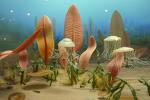 |
 |
 |
 |
 |
Produced
by the Population Genetics and Evolution class, Furman University |
||||
 |
 |
 |
 |
 |
Produced
by the Population Genetics and Evolution class, Furman University |
||||
 |
The
Ediacaran: Tribrachidium |
 |
| Tribrachidium
heraldicum, meaning “Heraldic three
arms” is a mysterious fossil (Waggoner 1994). It shows an abbreviated
spiral pattern with three arms at varying levels (White 2008). It was
first discovered and named in Australia by Martin Glaessner and Brian
Daily in 1959, but Tribrachidium can also be found in silliciclastic
sediments in the White Sea, Russia, and Ukraine. The most peculiar feature
of Tribrachidium is that it displays triradial symmetry, as opposed
to bilateral symmetry that most organisms display (Waggoner 1994). As
illustrated in the picture on the right, they are disc-shaped and are
about 5 cm in diameter. Their three curved arms extended from the center
towards the edge of their body. The arms were probably hollow, and it
is speculated that they could inflate or deflate as well. From the arms,
loose filaments or fleshy ridges extended to form the rest of the body
(Absolute Astronomy 2009). Tribrachidium are thought to be related
to either echinoderms or cnidarians, however this is still under debate
(Waggoner 1994). Some also believe that it’s not a whole animal,
but rather the holdfast of one. Others argue that it is not an animal
at all, but rather a protist or a member of a now extinct kingdom of multi-cellular
organisms (Wikipedia 2009).
Page by Lindsay Gerzel |
 |
| Tribrachidium fossil found in Australia. Photo
Credit: Waggoner,
B. 1994. Vendian Animals: Tribrachidium. UCMP. |
|
| Absolute
Astronomy. 2009. Tribrachidium.
Waggoner, B. 1994. Vendian Animals: Tribrachidium. University of California Museum of Paleontology (UCMP). Wikipedia. 2009. Tribrachidium. White, AT. 2008. Palaeos: The Vendobionta. www.Paleos.com. |